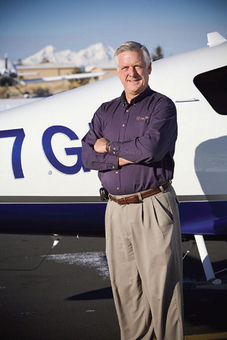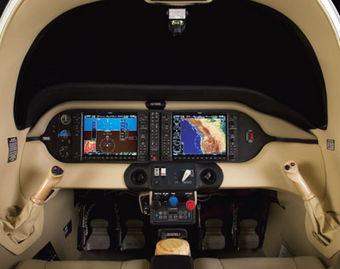Life After Bing (copyright Bend Business Review/Bend Living Magazine)
Columbia Aircraft seeks to smooth out the turbulence as Central Oregon’s aviation manufacturing titan
 Columbia
Aircraft—the leading manufacturer in the avionics cluster in Central
Oregon—hit a little turbulence in March when president and CEO Bing Lantis
resigned, the company laid off 59 workers, and temporarily furloughed 185
employees in the second large-scale restructuring over the past five years
for the homegrown airplane manufacturer. Aero-News reported in
March, that despite achieving record sales and deliveries in 2006, Columbia
Aircraft was hit with a six-month delay for its Garmin G1000 glass panel
installation. This was followed by a freak hail storm that required the
refinishing of more than 60 aircraft sitting on the ramp awaiting delivery.
Stepping in as new CEO, longtime Columbia Aircraft and aviation veteran, Wan
Abd Majid addressed Columbia owners in Club Columbia, a website for owners.
“We ask your indulgence as we take action in the coming months to improve
our business and your ownership experience.”
Columbia
Aircraft—the leading manufacturer in the avionics cluster in Central
Oregon—hit a little turbulence in March when president and CEO Bing Lantis
resigned, the company laid off 59 workers, and temporarily furloughed 185
employees in the second large-scale restructuring over the past five years
for the homegrown airplane manufacturer. Aero-News reported in
March, that despite achieving record sales and deliveries in 2006, Columbia
Aircraft was hit with a six-month delay for its Garmin G1000 glass panel
installation. This was followed by a freak hail storm that required the
refinishing of more than 60 aircraft sitting on the ramp awaiting delivery.
Stepping in as new CEO, longtime Columbia Aircraft and aviation veteran, Wan
Abd Majid addressed Columbia owners in Club Columbia, a website for owners.
“We ask your indulgence as we take action in the coming months to improve
our business and your ownership experience.”
Randy Bollinger, vice president of sales,
said that production has also been slowed to introduce new tooling
manufacturing processes. Although production has slowed, the company still
plans to deliver four aircraft per week. “This is nothing that you wouldn’t
see at Boeing or General Motors,” said Bollinger.
Since 2002, Columbia, then known as Lancair, has grown into an important
local manufacturer with up to 635 employees in 2006, and the lead tenant for
the Bend Airport. At least six suppliers of services and components have
grown successful businesses in Bend by being in the backyard of Columbia,
one of their larger clients.
 Companies
such as Snowline Manufacturing—which makes high-end structural flight
components—have followed Columbia to Bend from Redmond, where they started
out making components for Lancair. “Eighty percent of our business comes
from Columbia,” said general manager Art Knowles. “But we are supportive of
the changes there, and we are not concerned at this time.” Precise Flight,
another aviation supplier that at one time depended on Columbia for almost
one third of its revenues, now sees 10 to 15 percent of its revenues coming
from the manufacturer. Precise Flight said that it is now the largest
supplier of aviation high-intensity discharge lights and oxygen in the
world. The present impact of aircraft manufacturers like Columbia and Epic
Air means that Bend, with nearly 1,400 jobs in the aviation-manufacturing
industry, has the largest concentration of aircraft-related manufacturing in
the state, said Roger Lee, of Economic Development for Central Oregon. “Epic
Air is getting ready to hire as many people as were furloughed at Columbia,”
said Lee.
Companies
such as Snowline Manufacturing—which makes high-end structural flight
components—have followed Columbia to Bend from Redmond, where they started
out making components for Lancair. “Eighty percent of our business comes
from Columbia,” said general manager Art Knowles. “But we are supportive of
the changes there, and we are not concerned at this time.” Precise Flight,
another aviation supplier that at one time depended on Columbia for almost
one third of its revenues, now sees 10 to 15 percent of its revenues coming
from the manufacturer. Precise Flight said that it is now the largest
supplier of aviation high-intensity discharge lights and oxygen in the
world. The present impact of aircraft manufacturers like Columbia and Epic
Air means that Bend, with nearly 1,400 jobs in the aviation-manufacturing
industry, has the largest concentration of aircraft-related manufacturing in
the state, said Roger Lee, of Economic Development for Central Oregon. “Epic
Air is getting ready to hire as many people as were furloughed at Columbia,”
said Lee.
As general aviation maintains its strong presence in Bend, Columbia Aircraft
will no doubt see horizons brighter than it is facing now. In the past, the
company has hit turbulence and fl own right through. Under Bing Lantis,
former CEO, the company grew from a small kit plane manufacturer struggling
to build its first certified plane, to the manufacturer of the nation’s
fastest certified single-piston aircraft.
When Bing Lantis came on with Columbia Aircraft Manufacturing Company in
2002, the company had already built one of the best values on the market.
The Columbia 300 was poised and ready to meet the demand of pilots who
wanted the best in performance and most advanced composite technology. But
Lancair produced only four aircraft in five months, far from the scheduled
100 aircraft for that year—and then production was stopped for lack of
financing. Even if the aircraft manufacturer had hit its production goal of
100 that year, it would still have been making planes at a loss.
 Lantis
immediately began securing the most important factor in aircraft
manufacturing: believers with money. He then focused Columbia’s engineers on
creating a digital model of the airplane that could be used for analysis, as
well as requiring tooling departments to fine-tune their processes for more
efficient production.
Lantis
immediately began securing the most important factor in aircraft
manufacturing: believers with money. He then focused Columbia’s engineers on
creating a digital model of the airplane that could be used for analysis, as
well as requiring tooling departments to fine-tune their processes for more
efficient production.
Four years later, Lantis had the company where he wanted it, where it needed
to be. By 2006, Columbia manufactured aircraft at the profitable pace of one
per day.
Columbia’s success followed the rising trend of the general aviation
industry in the U.S. The Aircraft Owners and Pilot Association (AOPA),
reports that shipments of private aircraft have increased 65 percent over
the past five years. Crowded airlines and the inconvenience of airports
after 9/11 brought a surge in demand for private planes that has ensued for
the past five years.
In the industry, Columbia is not only known for its financial turnaround
story, but also for building the fastest certified single-piston powered
airplane in the world, flying at 235 knots, or 270 mph. The Columbia 400,
runs about $600,000 and holds the record in its certified engine class for
speed. The custom-built Columbia 350 at $485,000 has the same streamlined
styling without the turbocharged speed or the price tag. It’s a hefty price
but alluring to many small business owners and convenient for spontaneous
wanderers.
Sherry Gettinger, from Asheville, North Carolina, bought a Columbia 350 for
both recreation and business. She had all but signed papers on a Cessna 182
when a sales representative offered her a test flight in the Columbia 350.
“After spending the day in the Columbia, I knew it was the plane for me,”
she said. “It handles like a dream.”
Gettinger’s own sleek white and navy blue Columbia 350 with racy red pin
stripes was primped and preened and displayed in the sales room at Columbia
Aircraft. Last November, camera crews captured it in a celebration of the
500th aircraft at Columbia. For Lantis, this was more than a number, it was
a validation of a retooled strategy that has paid off , and it realized the
success of a childhood dream.
 His
fascination with airplanes began when his friend’s parents were offering
rides in an old tail-dragger plane in a nearby pasture. To Lantis’ stunned
surprise, his mother said an old trail-dragger was no place for a
four-year-old boy.
His
fascination with airplanes began when his friend’s parents were offering
rides in an old tail-dragger plane in a nearby pasture. To Lantis’ stunned
surprise, his mother said an old trail-dragger was no place for a
four-year-old boy.
Years later, when he got married, Lantis told his new bride that he didn’t
have enough money for a honeymoon. Miraculously though, he managed to scrape
together enough money for flight lessons a few months later.
After a career in engineering and aviation, including two years reviving the
French-owned Mooney Aircraft, Lantis began consulting.
“After my two years at Mooney,” Lantis recalled with a laugh, “I was now an
expert, so I tried some general aviation consulting.”
In his consulting gig, Lantis worked with Lancair, a company that wanted
Federal Aviation Administration (FAA) certification for its hot-rod kit
plane and wanted to begin production. Lantis understood the immensity of the
capital and patience needed.
Lantis’ experience in managing machinery and aircraft manufacturing plants,
his ability to rehabilitate ailing companies, as well as his experience with
foreign entities, proved to be the right combination when the Ministry of
Finance of Malaysia (which today still owns more than 90 percent of
Columbia), was looking
for a fresh start with Lancair.
The company’s founder, Lance Neibauer, had sounded the starter’s gun by
getting the aircraft FAA certified. But the production process was the long
road to profit. Unlike most manufacturing companies, every slight change in
the manufacturing of an airplane has to earn approval of the regulatory
body—the FAA. Th is time-consuming process adds weeks, sometimes months, to
the production process. Lantis said that Lancair’s founders had
underestimated by a factor of 10 the enormous amount of time it took for
this process, and things “started to go sour.”
 “It
is not like an RV where, if something breaks down, you can pull it over to
the side of the road,” said Dave Ellickson, a research and development
technician who has been with Columbia since 1998. “You can’t hide mistakes.
You have to do exactly what you tell the FAA you are going to do within that
certificate. Safety has to be number one.”
“It
is not like an RV where, if something breaks down, you can pull it over to
the side of the road,” said Dave Ellickson, a research and development
technician who has been with Columbia since 1998. “You can’t hide mistakes.
You have to do exactly what you tell the FAA you are going to do within that
certificate. Safety has to be number one.”
As Lantis began to drive the factory into profitable production, both
employees of Columbia Aircraft and the community of Bend felt the effects.
Ellickson said he remembers “the days when we had to roll an aircraft with
no landing gear out on a dolly because it was the only one ready enough for
a photo shoot.” Management has changed since the days when there were rumors
and questions of whether the company would succeed. Ellickson said that
“Lantis was Columbia management,” and because of the company’s success and
profitability, “that reflected well in my personal success and security for
my family.” Ellickson has been through many changes at Columbia, and he
believes that the current changes will also lead to a stronger company.
Today, Lantis is happy to be home tending to his ailing wife. Columbia said
it hopes to recall all furloughed employees over the course of April and
May. The aviation industry in Bend will continue to grow, with Epic Air
announcing record sales at an industry event in April, but Columbia will
have to find a new pilot who has the Lantis touch.
©Bend Business Review:
http://www.bendliving.com/BUSINESS/Bend_Business_Review/Columbia_Aircraft/